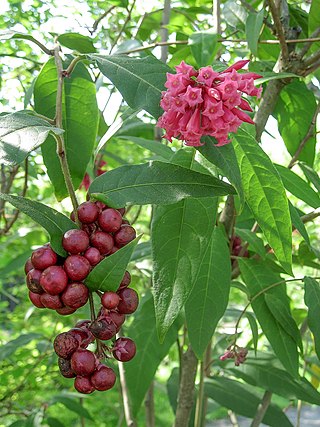
In biology, coevolution occurs when two or more species reciprocally affect each other's evolution through the process of natural selection. The term sometimes is used for two traits in the same species affecting each other's evolution, as well as gene-culture coevolution.

Petunia is a genus of 20 species of flowering plants of South American origin. The popular flower of the same name derived its epithet from the French, which took the word pétun, 'tobacco', from a Tupi–Guarani language. A tender perennial, most of the varieties seen in gardens are hybrids.

Sunbirds and spiderhunters make up the family Nectariniidae of passerine birds. They are small, slender passerines from the Old World, usually with downward-curved bills. Many are brightly coloured, often with iridescent feathers, particularly in the males. Many species also have especially long tail feathers. Their range extends through most of Africa to the Middle East, South Asia, South-east Asia and southern China, to Indonesia, New Guinea and northern Australia. Species diversity is highest in equatorial regions.

Heliconia is a genus of flowering plants in the monotypic family Heliconiaceae. Most of the ca 194 known species are native to the tropical Americas, but a few are indigenous to certain islands of the western Pacific and Maluku in Indonesia. Many species of Heliconia are found in the tropical forests of these regions. Most species are listed as either vulnerable or data deficient by the IUCN Red List of threatened species. Several species are widely cultivated as ornamentals, and a few are naturalized in Florida, Gambia, and Thailand.

Streptosolen is a monotypic genus of flowering plants in the family Solanaceae. It is closely related to the genus Browallia, within which it was originally placed. The single species, Streptosolen jamesonii, the marmalade bush or fire bush, is an evergreen shrub bearing loose clusters of flowers which change gradually from yellow to red as they develop, resulting in an overall appearance resembling orange marmalade, found in open woodlands in Colombia, Venezuela, Ecuador, and Peru. In its native Ecuador, the plant has the Spanish common names flor de quinde, flor del sol and jaboncillo.

Iochroma is a genus of about 34 species of shrubs and small trees belonging to the nightshade family Solanaceae. Species are native from Mexico to south Brazil. They are found in the forests of Mexico and South America. Their hummingbird-pollinated flowers are tubular or trumpet-shaped, and may be blue, purple, red, yellow, or white, becoming pulpy berries. The cupular (cup-shaped) calyx is inflated in some species. The leaves are alternate, simple, and entire.

A nectar source is a flowering plant that produces nectar as part of its reproductive strategy. These plants create nectar, which attract pollinating insects and sometimes other animals such as birds.

Ornithophily or bird pollination is the pollination of flowering plants by birds. This sometimes coevolutionary association is derived from insect pollination (entomophily) and is particularly well developed in some parts of the world, especially in the tropics, Southern Africa, and on some island chains. The association involves several distinctive plant adaptations forming a "pollination syndrome". The plants typically have colourful, often red, flowers with long tubular structures holding ample nectar and orientations of the stamen and stigma that ensure contact with the pollinator. Birds involved in ornithophily tend to be specialist nectarivores with brushy tongues and long bills, that are either capable of hovering flight or light enough to perch on the flower structures.

Schizanthus, also called butterfly flower, fringeflower, poor-man's-orchid, is a genus of plants in the nightshade family, Solanaceae.
Markea is a genus of plant in family Solanaceae. It contains the following species :

In ethology and behavioral ecology, trap-lining or traplining is a feeding strategy in which an individual visits food sources on a regular, repeatable sequence, much as trappers check their lines of traps. Traplining is usually seen in species foraging for floral resources. This involves a specified route in which the individual traverses in the same order repeatedly to check specific plants for flowers that hold nectar, even over long distances. Trap-lining has been described in several taxa, including bees, butterflies, tamarins, bats, rats, and hummingbirds and tropical fruit-eating mammals such as opossums, capuchins and kinkajous. Traplining is used to term the method in which bumblebees and hummingbirds go about collecting nectar, and consequently, pollinating each plant they visit. The term "traplining" was originally coined by Daniel Janzen, although the concept was discussed by Charles Darwin and Nikolaas Tinbergen.

Cestrum elegans, the purple cestrum, red cestrum, or bastard jasmine, is a species of flowering plants in the genus Cestrum.

Capsicum is a genus of flowering plants in the nightshade family Solanaceae, native to the Americas, cultivated worldwide for their chili pepper or bell pepper fruit.

The Solanaceae, or the nightshades, are a family of flowering plants that ranges from annual and perennial herbs to vines, lianas, epiphytes, shrubs, and trees, and includes a number of agricultural crops, medicinal plants, spices, weeds, and ornamentals. Many members of the family contain potent alkaloids, and some are highly toxic, but many—including tomatoes, potatoes, eggplant, bell and chili peppers—are used as food. The family belongs to the order Solanales, in the asterid group and class Magnoliopsida (dicotyledons). The Solanaceae consists of about 98 genera and some 2,700 species, with a great diversity of habitats, morphology and ecology.

Cestroideae is a subfamily of the plant family Solanaceae, the nightshades.

Petunioideae is a subfamily of the flowering plant family Solanaceae, the nightshades. It contains thirteen genera, as follows:

Witheringia is a genus of flowering plants in the family Solanaceae, with a neotropical distribution. It is closely related to Physalis.
Darcyanthus is a monotypic genus of flowering plants belonging to the family Solanaceae. The single known species is Darcyanthus spruceanus(Hunz.) Hunz. ex N.A.Harriman
Leptoglossis is a genus of flowering plants belonging to the family Solanaceae.
Plowmania is a monotypic genus of flowering plants belonging to the family Solanaceae. The only species is Plowmania nyctaginoides.















